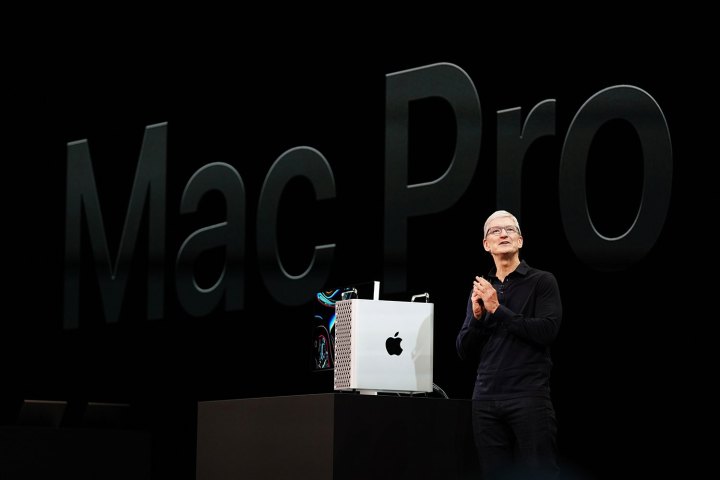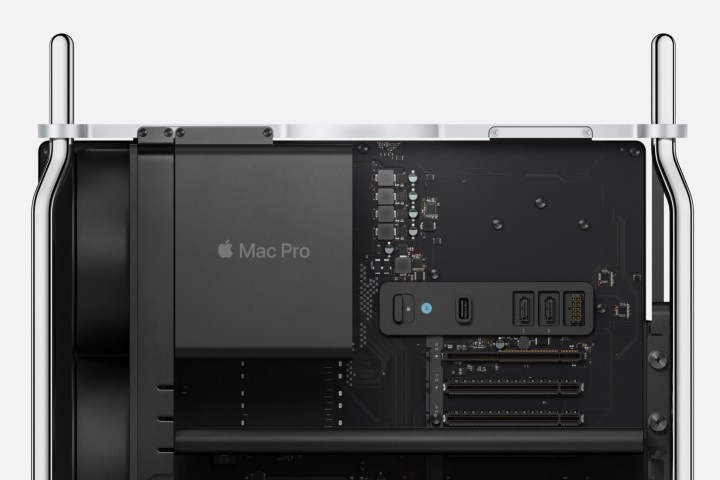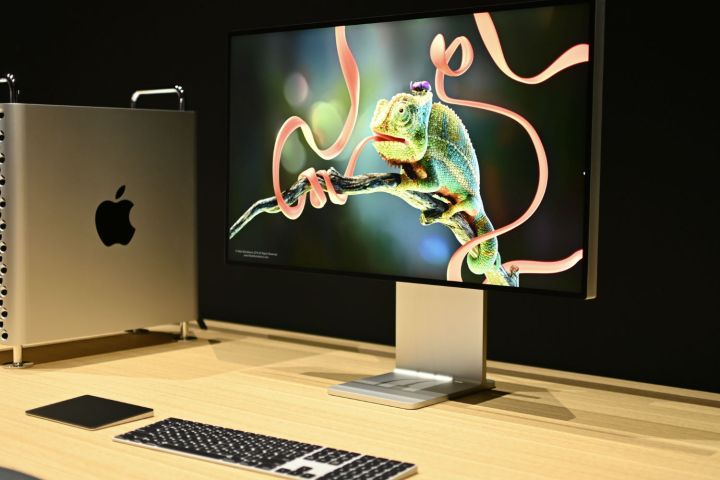The Mac Pro is Apple’s most powerful Mac. Or at least, that’s the intention, but since its release in 2019, Apple has gone on to release new MacBooks with powerful M1 Max chips that are banging on the $6,000 Mac Pro’s door. That means an update is in order.
Luckily, rumors and leaks indicate a new Mac Pro could still be just a few months away. If you’re wondering what it might look like and how powerful it could be, you’re in the right place, as we’ve gathered all the Mac Pro news we can find into one place. To find out what’s on the horizon for Apple’s flagship desktop dominator, read on.
Price and release date

It’s often hard to scry anything from Apple’s inscrutable crystal ball, but we feel reasonably confident predicting this: The next Mac Pro is coming in 2022. And there’s a simple reason for this conviction.
In June 2020, Apple said at its Worldwide Developers Conference (WWDC) event that its complete transition to Apple silicon would take about two years. Even if we permit Apple some leeway and give it until November (two years since the first M1 MacBook launched) instead of June, the hard deadline still sits at the end of 2022. In other words, that means it’s almost certain we will see an Apple silicon Mac Pro by the end of 2022 at the latest.
We were expecting an announcement on the Mac Pro at Apple’s WWDC event, but no such announcement came. Now it’s back to the drawing board to determine when Apple’s newest professional computer will release and what it might contain. Previous rumors had suggested two models — one bearing an Intel chip, another with an Apple silicon chip — could be on the way. However, it seems these rumors might have confused the Mac Studio for a small-scale Mac Pro, meaning only one model is now expected. Given Apple prominently teased at WWDC that the Mac Pro would soon transition to Apple silicon, the Intel model seems very much in doubt.
We’re expecting the Apple silicon Mac Pro to come later this year. With this model, Apple has got to make a high-end chip that demanding pros are happy with — something it’s gaining experience doing after launching M1 Max and M1 Ultra chips. The Mac Pro needs to be powered by a chip that is potentially even more performant than the M1 Ultra in the Mac Studio. According to journalist Mark Gurman, we’ll get that, with Apple planning to launch a Mac Pro with an M2 Extreme chip in late 2022, then release it in 2023 (probably in the spring or summer).
And how about the price? We’re probably looking at something similar to the current $5,999 starting price, although the Apple silicon Mac Pro might be more affordable if it comes in the smaller enclosure.
Design and features

Now that the Mac Studio has been released, we can pretty much forget the previously rumored half-sized Mac Pro, as the Mac Studio seems to match that description pretty well.
That said, it’s not as simple as saying the new Mac Pro will simply use the old one’s chassis. While that’s certainly one option — and would save Apple some money — there’s another consideration: Apple silicon. As we saw with the 24-inch iMac and M2 MacBook Air, Apple has been able to design its products around its new chips. Since they are cooler and more efficient, Apple has been able to design thinner machines. Might that be the case with the Mac Pro?
It’s possible, but we haven’t heard anything pointing toward this from all the usual tipsters. With the Mac Pro’s release date on the horizon, we’d have thought we would have heard about a redesigned chassis by now, so the safest bet is probably that Apple will just stick with the current design for another iteration.
That means we can expect it to keep its modular design, as this was a key selling point of the 2019 version and appeals to professional users who are more willing to get hands-on with their kit than the average consumer.
Super-powerful performance

The idea of Apple launching an Intel-based Mac Pro seems increasingly remote now that Apple has launched several pro-level chips of its own. As well as that, Mark Gurman has repeatedly claimed that Apple is working on an even more powerful piece of silicon called the M2 Extreme.
Gurman had previously reported that Apple was working on a chip with 16 high-performance cores and four high-efficiency cores, along with a 64-core graphics chip, which turned out to be a variant of the M1 Ultra. Besides that, Gurman also stated that another chip was in the works, with 32 high-performance cores and eight high-efficiency cores, plus a 128-core GPU. It’s this chip that looks to be the M2 Extreme.
This chip could use a multi-die configuration, according to developer Hector Martin, since MacOS allegedly contains numerous references to this possibility. In other words, we could see two (or potentially four) chips essentially fused together into one larger system-on-a-chip (SoC) — something that could also make an appearance in the upcoming iMac Pro. That idea of fusing chips is something that Gurman agrees with, stating in an interview with YouTube channel Max Tech that the M2 Extreme will be two M2 Ultra chips bonded together.
There’s something else to guide us here. According to recent benchmarks, the M1 Max chip inside the latest MacBook Pro is up to three times faster than the 2019 Mac Pro in some situations, such as exporting ProRes video. The Apple silicon chips inside the upcoming Mac Pro refresh will have to be at least this fast to make them attractive to high-end buyers. That kind of power is exciting to think about.
And since each Apple chip is configured as an SoC, that means there might be no need for the AMD graphics cards currently used in the Mac Pro. Apple’s own Mac Pro chips will have to be at least as graphically powerful as those cards to make the transition worthwhile.
New monitors, including a fresh Pro Display XDR

When Apple launched the redesigned Mac Pro in December 2019, it also brought out a $4,999 32-inch companion monitor called the Pro Display XDR. This high-end device was designed to be used with the Mac Pro and keep up with its incredibly demanding workloads. It came with 6K resolution, 500 nits of brightness, what Apple termed an Extreme Dynamic Range, and an eye-wateringly expensive $999 monitor stand.
When Apple updates the Mac Pro in 2022, it’s almost certain the Pro Display XDR will also get a refresh, as the two products are designed to be used together. And there’s some evidence Apple is preparing at least one new monitor to accompany the Mac Pro.
Bloomberg’s Mark Gurman reported in January 2021 that Apple was developing a “lower-priced external monitor to sell alongside the Pro Display XDR.” Although details were scarce at the time, Gurman commented that it was “geared more for the consumer than professional use and wouldn’t have the brightness and contrast ratio of the top-tier offering.”
Almost a year later, Twitter leaker Dylandkt provided some more details. According to their information, Apple is working with LG on a handful of external monitors in three sizes: 24 inches, 27 inches, and 32 inches.
The 27-inch and 32-inch models are said to pack in mini-LED panels with Apple’s ProMotion tech. This offers variable refresh rates up to 120Hz and is found in the new MacBook Pro, and it’s rumored for the upcoming iMac Pro relaunch. The 32-inch model could also come with a custom Apple silicon chip, perhaps an updated version of the timing controller chip that modulates the current Pro Display XDR’s LCD pixels and LED backlighting.
One of these monitors could be the lower-cost external display mentioned by Mark Gurman, while the 32-inch version seems likely to be an updated Pro Display XDR. Combined, the three of them should give Mac users much more choice when it comes to external displays.
Editors’ Recommendations




